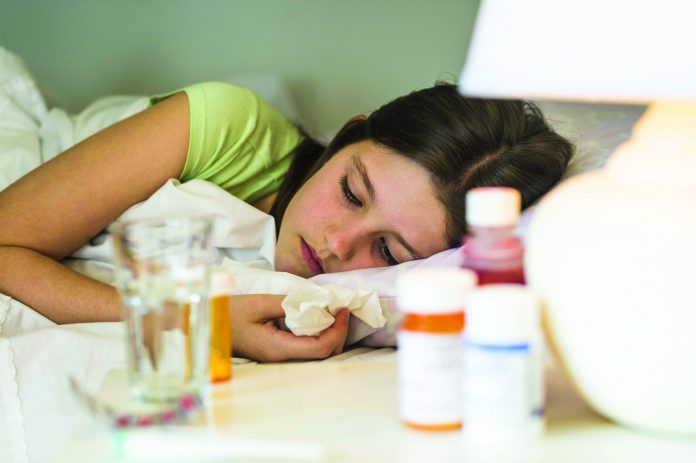Family and friends will be getting together this week to eat and rejoice in the Thanksgiving holiday. But with the triple threat of COVID-19, respiratory syncytial virus — known as RSV — and influenza driving up infections this season, there are some suggested precautions people can take.
Dr. Dale Bratzler, chief COVID officer at the University of Oklahoma, said the practices that people should adopt to protect against all three are the same.
“They’re respiratory viruses and they spread particularly when people congregate in indoor settings,” Bratzler said, “so when you get a crowd of people indoors and people that aren’t wearing masks — obviously, that’s when these viruses tend to spread.”
“That’s why we typically see outbreaks of influenza and RSV during the winter months when it’s cold outside,” he added. “People come inside and congregate indoors.”
Bratzler noted there has been a “fairly substantial” increase in cases of upper respiratory diseases.
In Hidalgo County, three residents died due to COVID-related complications, the county reported this week.
Those who died included a Pharr woman and two men over 70, one from Edinburg and the other from an undisclosed location in Hidalgo County. All three individuals were not vaccinated.
Their deaths raise the county’s total number of COVID-related deaths to 4,038.
Hidalgo County also reported 342 new cases this week, including 121 confirmed and 225 probable cases.
As of Friday, there were eight people hospitalized with the flu throughout the county.
In Cameron County, there were no COVID-related deaths reported this week, keeping their total number of COVID-19 deaths at 2,313.
County officials, though, reported 208 new cases this week which included 71 confirmed cases and 137 probable cases.
Last week, there were more than 25 cases of RSV confirmed through PCR tests in Public Health Region 11, a 19-county area in South Texas that includes the Rio Grande Valley.
Around the same time last year, there were only about 10 cases of RSV confirmed through PCR tests in the region, according to data from the Texas Department of State Health Services.
The rise in cases is likely because for the past two years, most people were practicing many of the COVID precautions like wearing masks and social distancing which led to a reduction of all respiratory viruses.
But that also meant our immune systems weren’t exposed to them and didn’t build up protections against them during that time.
“Many kids who typically would have been exposed on a regular basis each year have not been exposed for the past couple of years, and so we’ve seen a fairly large increase in the number of hospitalizations of children due to RSV,” Bratzler said.
An RSV infection in kids causes bronchiolitis, which is when the small airways of the lungs become plugged and swollen, making it difficult for the kids to breathe.
While cases of RSV in children have garnered the most attention — albeit, with good reason — Bratzler said it is also common in the elderly and, in fact, kills more adults than children. About 100 to 300 kids in the U.S. die each year from RSV while 3,000 or more adults die from the disease during that time.
“In the elderly — particularly when people start getting up to age 65, 70 — or people who have chronic illness or are immunocompromised, RSV can cause severe pneumonia in those patients also,” he said.
There currently is no vaccine or antivirals to treat RSV.
There is a flu vaccine available, however, and a bivalent booster dose of the COVID-19 vaccine that was released in September which federal, state and local officials have urged people to take advantage of.
By far, the most important thing to protect against the flu and COVID, was to get vaccinated, Bratzler said.
“For influenza, the vaccine is not perfect but it reduces your chance of severe flu disease,” Bratzler said, “and the COVID-19, the new bivalent booster, seems to be quite important at reducing the risk of breakthrough infections that may occur in some people; it slows the spread of the virus.”
He advised that people, particularly those at risk for those three diseases, should avoid indoor crowds and should wear masks.
But three years into the COVID-19 pandemic, many people will be getting together with families, regardless of the warnings.
With those gatherings being inevitable, Bratzler said people can still take care of who they are around.
“What I always tell people is — know the people that you’re going to be around,” he said. “If you’re around healthy young people, again, doesn’t mean you won’t spread the virus and that people won’t get sick, but we know those people tend to do reasonably well with these infections.”
For individuals who are sick — experiencing cold-like symptoms such as coughing or sneezing — he strongly encouraged them to not go out in public if you’re sick so they can help slow the spread of these diseases.
“Truly, the most important (precautions) are the ones that we’ve been doing,” Bratzler said. “And hygiene, wearing a mask, social distancing — that’s the best way to slow the spread of RSV.”





